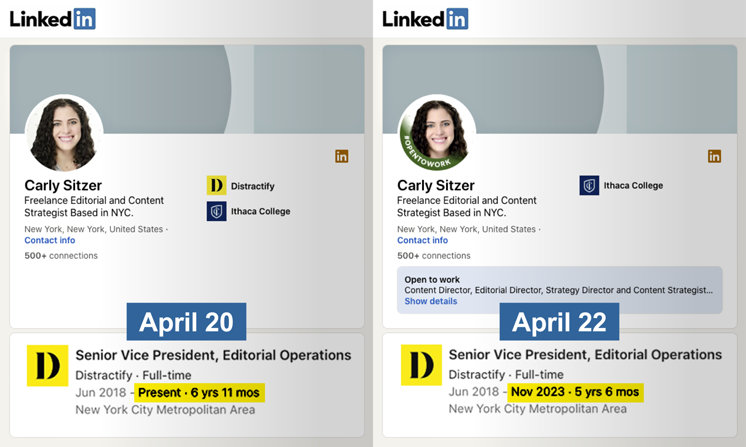Now, the plot thickens—again. The editor listed on Distractify’s website at the time of the article’s publication was Carly Sitzer. Except now, after Freedom called Sitzer out for Distractify’s journalistic malpractice, Sitzer now claims she doesn’t work there anymore, overnight becoming the “former” SVP of Editorial Operations on the company’s site. Sitzer’s LinkedIn, meanwhile, now states she’s newly a freelancer “open to work.” And on Muck Rack? She’s listed as the current head of Distractify editorial. If she is this confused about where she works, no wonder the rest of us are having such a hard time.
To be clear: Sitzer was the loud and proud editor of Distractify across all internet profiles—including her own page on the site—all the way up until April 20, 2025. But upon discovering that Freedom would not simply rip her name off our article after she sent us an email, she suddenly found the energy to “update” her profiles—or at least some of them … sort of—energy she had been lacking the ability to muster for 17 months.
Everyone affiliated with Distractify is perfectly happy to have their name associated with it—so long as it’s convenient.
By way of background, on April 9, Freedom reached out to Sitzer with questions about the mysterious Jennifer Farrington byline change. Sitzer never answered. Instead, she emailed Freedom on April 18 claiming she hadn’t heard a word from us and that she had not been affiliated with Distractify since “late 2023.”
So, in a follow-up email exchange, we asked Sitzer to clarify:
- Whether she was serving as editor at Distractify when the March 11 article was published;
- Why all pages we could locate still listed her as editor; and
- Whether she had any editorial involvement—directly or indirectly—with the article in question.
Her responses to our three questions were unequivocal:
- “As I’ve previously stated, no.”
- “The pages were outdated, and my profiles have since been updated.”
- “I had no involvement whatsoever as I have not been employed by the company since November 2023.”
She concluded with a request: “Please remove any mentions of my name, and confirm once the story has been updated.”

Carly Sitzer, it appears, is pulling a Jennifer Farrington—except this time, it wasn’t changing the byline, but trying to change the actual masthead (and LinkedIn) on which Sitzer has been happily listed as the editor of a publication she claims she hasn’t had anything to do with since 2023.
It would all be thoroughly plausible except for one tiny problem: Distractify has a track record of just this brand of outrageous dishonesty. It’s what Freedom was exposing in the first place: Distractify will gladly remove the names of real people and replace them with fake ones, because the real people don’t want to be held accountable for the real garbage they write or oversee.
Case in point: Jennifer Farrington—the “reporter” who started this whole mess—vanished, using a fabricated identity as a mask, after being called out for authoring her bigoted, hateful article attacking Scientology.
Everyone affiliated with Distractify is perfectly happy to have their name associated with it—so long as it’s convenient.
Of course, that’s not journalism. That’s reputational laundering. And at this point, it’s hard not to wonder who Farrington learned it from—likely from Carly Sitzer herself, the woman who thought we wouldn’t notice that her “updated” LinkedIn profile still said she works at Distractify “to present,” as does her “updated” Muck Rack, which hasn’t been updated at all.
We asked the same question about Farrington: How stupid does she think we are?
And just how much disdain does Distractify have for their readers?

The Farrington scandal is no innocent mix-up of author credits. The “Reese Watson” persona is a blatant fake, constructed from a stock image and placeholder email, with no traceable journalistic history. It is not a pen name but a shield—a smokescreen erected after Farrington’s inflammatory article drew backlash. In that sense, the true scandal isn’t just about who wrote the piece—it’s about who hid behind it.
If Sitzer wasn’t responsible, who was? And, above all, who at Distractify believes readers don’t deserve to know who writes what? After all, Sitzer didn’t just “lie”—she committed what some might call perjury in the court of public stupidity, twice. By all available records, she edited the truth—now it’s editing her reputation.

Stock-photo avatars. Rerouted emails. An editor who disappears only when questions appear. Everyone affiliated with Distractify is perfectly happy to have their name associated with it—so long as it’s convenient. These are not the trappings of a newsroom. They’re the signs of a brand hiding behind content, hoping the audience won’t look too closely.
Sitzer and her (former?) publication’s obfuscation tactics are a symptom of a wider illness: the utter lack of editorial accountability in the click-first, verify-later digital era. Media platforms that depend on algorithms and ad revenue now often treat journalism as packaging—not process.
This is how credibility erodes: not in dramatic scandals, but in the shrug of indifference. A byline evaporates. An editor disavows. A question goes unanswered.
We’re still asking.
But finally, let’s play along with Sitzer. Let’s say she did, in fact, stop working at Distractify in 2023. Her fake reporter, Reese Watson, has been digitally alive and kicking since three years prior to that, starting in 2020. And, if we are to believe Sitzer’s own LinkedIn, she has been at Distractify since 2018. So “Reese” may very well be the brainchild of Sitzer herself.
That’s why we invited Sitzer to comment more broadly on Distractify’s editorial practices, past and present.
She declined.






















